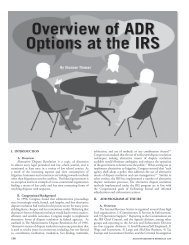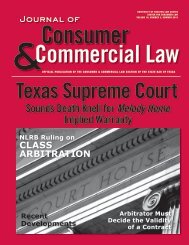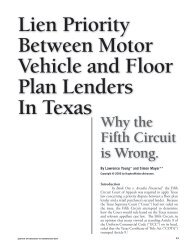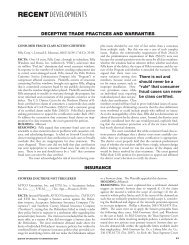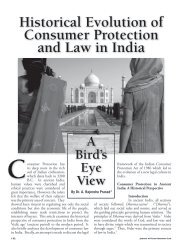Teaching Consumer Credit Law in an Evolving Australian Economy
Teaching Consumer Credit Law in an Evolving Australian Economy
Teaching Consumer Credit Law in an Evolving Australian Economy
Create successful ePaper yourself
Turn your PDF publications into a flip-book with our unique Google optimized e-Paper software.
sumer relationship, but rather<br />
makes it actionable under the<br />
DTPA to “obta<strong>in</strong>, possess,<br />
tr<strong>an</strong>sfer, or use personal identify<strong>in</strong>g<br />
<strong>in</strong>formation of <strong>an</strong>other<br />
person without the other person’s<br />
consent <strong>an</strong>d with <strong>in</strong>tent<br />
to obta<strong>in</strong> a good, a service, <strong>in</strong>sur<strong>an</strong>ce,<br />
<strong>an</strong> extension of credit,<br />
or <strong>an</strong>y other th<strong>in</strong>g of value <strong>in</strong><br />
the other person’s name.” 84 The<br />
tie-<strong>in</strong> states “[a] violation of<br />
Section 521.051 is a deceptive<br />
trade practice actionable under<br />
Subchapter E, Chapter 17.” 85<br />
A claim<strong>an</strong>t with respect to<br />
the Identity Theft Enforcement <strong>an</strong>d Protection Act is one who<br />
has had their identity taken without their consent <strong>an</strong>d with <strong>in</strong>tent<br />
to obta<strong>in</strong> a good, a service, <strong>in</strong>sur<strong>an</strong>ce, <strong>an</strong> extension of credit, or<br />
<strong>an</strong>y other th<strong>in</strong>g of value <strong>in</strong> the other person’s name. There is no<br />
need for <strong>an</strong>y type of consumer/merch<strong>an</strong>t relationship pursu<strong>an</strong>t to<br />
the pla<strong>in</strong> l<strong>an</strong>guage of this Act.<br />
(i) The Regulation of Certa<strong>in</strong> Electronic Mail Claim<strong>an</strong>t<br />
This chapter of the Bus<strong>in</strong>ess <strong>an</strong>d Commerce Code makes<br />
actionable certa<strong>in</strong> unsolicited commercial emails. 86 Interest<strong>in</strong>gly<br />
<strong>an</strong> established bus<strong>in</strong>ess relationship (such as a merch<strong>an</strong>t/consumer<br />
relationship) precludes a commercial email from be<strong>in</strong>g unsolicited.<br />
87 This chapter generally addresses emailed solicitations<br />
that are not authorized by the recipient. Thus not only is there no<br />
need for a consumer/merch<strong>an</strong>t relationship under this chapter,<br />
the existence of one may well underm<strong>in</strong>e a claim brought under<br />
this chapter. To argue that only a “DTPA consumer” is a proper<br />
claim<strong>an</strong>t when the tie-<strong>in</strong> statue itself precludes “DTPA consumer”<br />
status leads to <strong>an</strong> absurd result. This is contrary to established<br />
rules of statutory construction that state “we must not construe<br />
statutes <strong>in</strong> a way that would lead to <strong>an</strong> absurd result.” 88<br />
2. Flaws <strong>in</strong> Reason<strong>in</strong>g by the Marketic Court <strong>an</strong>d its Progeny<br />
The cases that follow Marketic suffer from a number of serious<br />
flaws. The follow<strong>in</strong>g is a brief summary of some of these po<strong>in</strong>ts.<br />
(a) “Claim<strong>an</strong>t” Rather th<strong>an</strong> “<strong>Consumer</strong>”<br />
Neither Marketic nor its progeny expla<strong>in</strong> why the legislature<br />
used claim<strong>an</strong>t rather th<strong>an</strong> consumer. The l<strong>an</strong>guage used <strong>in</strong> section<br />
17.50(h) provides:<br />
[n]otwithst<strong>an</strong>d<strong>in</strong>g <strong>an</strong>y other provision of this subchapter,<br />
if a claim<strong>an</strong>t is gr<strong>an</strong>ted the right to br<strong>in</strong>g a cause of<br />
action under this subchapter by <strong>an</strong>other law, the claim<strong>an</strong>t<br />
is not limited to recovery of economic damages only,<br />
but may recover <strong>an</strong>y actual damages <strong>in</strong>curred by the<br />
claim<strong>an</strong>t, without regard to whether the conduct of the<br />
defend<strong>an</strong>t was committed <strong>in</strong>tentionally.<br />
The Legislature could have said:<br />
[n]otwithst<strong>an</strong>d<strong>in</strong>g <strong>an</strong>y other provision of this subchapter,<br />
if a consumer is gr<strong>an</strong>ted the right to br<strong>in</strong>g a cause of<br />
action under this subchapter by <strong>an</strong>other law, the consumer<br />
is not limited to recovery of economic damages<br />
only, but may recover <strong>an</strong>y actual damages <strong>in</strong>curred by<br />
the consumer, without regard to whether the conduct of<br />
the defend<strong>an</strong>t was committed <strong>in</strong>tentionally.<br />
Section 17.50(h) of the DTPA is the only section of the Act<br />
that uses the word “claim<strong>an</strong>t,” <strong>an</strong>d it is used repeatedly. The legislature<br />
was clear <strong>an</strong>d unambiguous when it said that a claim<strong>an</strong>t is<br />
entitled to br<strong>in</strong>g a claim under the DTPA <strong>an</strong>d c<strong>an</strong> recover up to<br />
three times actual damages. This<br />
is pla<strong>in</strong> on the face of subsection<br />
17.50(h). “[A] card<strong>in</strong>al rule<br />
of statutory construction is that<br />
each sentence, clause <strong>an</strong>d word<br />
is to be given effect if reasonable<br />
<strong>an</strong>d possible.” 89 When, as here,<br />
“the statute unambiguously<br />
demonstrates the Legislature’s<br />
<strong>in</strong>tent <strong>an</strong>d thus the statute’s<br />
me<strong>an</strong><strong>in</strong>g, the Court must not resort<br />
to extr<strong>in</strong>sic aids to hypothesize<br />
about <strong>an</strong> <strong>in</strong>tent the statute<br />
does not express.” 90<br />
Substitut<strong>in</strong>g the word consumer<br />
for the word claim<strong>an</strong>t<br />
also violates <strong>an</strong>other general statutory construction pr<strong>in</strong>ciple that<br />
courts should not <strong>in</strong>sert words <strong>in</strong> a statute except to give effect to<br />
clear legislative <strong>in</strong>tent. 91<br />
(b) Pre Tie-In Case <strong>Law</strong><br />
The tie-<strong>in</strong> statute, section 17.50(h), was enacted <strong>in</strong> 1995.<br />
References to cases that predate the 1995 amendment or that<br />
use the old law are improper. Prior to the 1995 enactments, the<br />
only private cause of action under the DTPA was for a consumer.<br />
Thus quotes from cases such as Melody Home Mfg. Co. v. Barnes, 92<br />
Mendoza v. Americ<strong>an</strong> Nat’l Ins. Co., 93 <strong>an</strong>d Figueroa v. West, 94 are<br />
improper <strong>in</strong> that they reference a prior version of the DTPA, requir<strong>in</strong>g<br />
consumer status. That is not the case after the enactment<br />
of subsection 17.50(h).<br />
(c) “Notwithst<strong>an</strong>d<strong>in</strong>g” L<strong>an</strong>guage<br />
As with the use of claim<strong>an</strong>t rather th<strong>an</strong> consumer, the use of<br />
“[n]otwithst<strong>an</strong>d<strong>in</strong>g <strong>an</strong>y other provision of this subchapter” l<strong>an</strong>guage<br />
at the beg<strong>in</strong>n<strong>in</strong>g of subsection (h) demonstrates the legislatures<br />
<strong>in</strong>tent that the provisions of subsection (h) are to control<br />
<strong>in</strong> the event that there are <strong>an</strong>y <strong>in</strong>consistences between it <strong>an</strong>d <strong>an</strong>y<br />
other provisions <strong>in</strong> the subchapter. 95 The requirement of consumer<br />
status for st<strong>an</strong>d<strong>in</strong>g under the DTPA as provided under subsection<br />
17.50(a) is, therefore, <strong>in</strong>ferior to the specific l<strong>an</strong>guage of<br />
subsection (h). Because subsection (h) was enacted <strong>in</strong> 1996 <strong>an</strong>d<br />
the consumer requirement was enacted <strong>in</strong> 1973, the subsection<br />
(h) l<strong>an</strong>guage should control as be<strong>in</strong>g drafted later <strong>in</strong> time under<br />
the rules of statutory construction. 96<br />
VI. THE BOTTOM LINE<br />
The l<strong>an</strong>guage of subsection 17.50(h) is either ambiguous or it is<br />
not. In this author’s op<strong>in</strong>ion it is not, <strong>an</strong>d clearly gives a claim<strong>an</strong>t<br />
st<strong>an</strong>d<strong>in</strong>g to ma<strong>in</strong>ta<strong>in</strong> a claim under the DTPA when authorized<br />
by <strong>an</strong>other statute. But even if it is ambigious, there is a m<strong>an</strong>date<br />
to construe the legislature’s use of the word “claim<strong>an</strong>t” as someth<strong>in</strong>g<br />
other th<strong>an</strong> “consumer.” The only <strong>in</strong>terpretation that harmonizes<br />
the legislature’s choice of “claim<strong>an</strong>t” rather th<strong>an</strong> “consumer”<br />
is the one that provides <strong>an</strong> alternative to consumer status by piggyback<strong>in</strong>g<br />
a claim onto the DTPA through subsection (h). All that<br />
a tie-<strong>in</strong> pla<strong>in</strong>tiff should have to allege to ma<strong>in</strong>ta<strong>in</strong> <strong>an</strong> action as a<br />
claim<strong>an</strong>t under subsection 17.50(h) is that he or she is authorized<br />
to do so by <strong>an</strong>other statute.<br />
St<strong>an</strong>d<strong>in</strong>g under the DTPA’s subsection 17.50(h) should be<br />
determ<strong>in</strong>ed by look<strong>in</strong>g at the <strong>in</strong>dividual tie-<strong>in</strong> statue to determ<strong>in</strong>e<br />
what group of pla<strong>in</strong>tiff’s were <strong>in</strong>tended by the legislature to br<strong>in</strong>g<br />
those claims under the DTPA <strong>an</strong>d through that specific tie-<strong>in</strong> statute.<br />
This construction is the only one that gives me<strong>an</strong><strong>in</strong>g to the<br />
legislature’s specific choice of l<strong>an</strong>guage <strong>an</strong>d is consistent with the<br />
controll<strong>in</strong>g l<strong>an</strong>guage at the beg<strong>in</strong>n<strong>in</strong>g of subsection (h).<br />
Any other <strong>in</strong>terpretation not only stra<strong>in</strong>s the l<strong>an</strong>guage of section<br />
17.50, but also results <strong>in</strong> arbitrary <strong>an</strong>d apparently un<strong>in</strong>tended<br />
Journal of <strong>Consumer</strong> & Commercial <strong>Law</strong> 23



